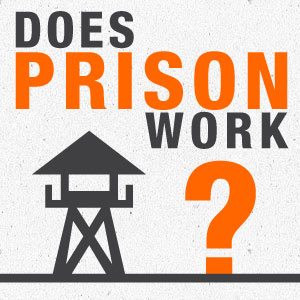Prison: Does it Work graphic discusses the corrections system in the United States and if it is effective.
Does Prison Work?
Since 1980 the US prison population has quadrupled. Some states pay as much to keep a person in prison as it would cost to pay tuition, room, board, and fees at Harvard. So we must ask the question, does prison work?
The US imprisons its people at the highest rate in the world. Among OECD countries, Israel comes in 2nd. While the US has 5% of the world’s population, it holds 25% of the world’s prisoners.
What is Prison For?
In America, the prison has historically had four major purposes:
- Retribution: punishment for committing a crime.
- Incapacitation: removing criminals from the streets.
- Deterrence: preventing future crime from being committed.
- Rehabilitation: helping inmates heal and become productive citizens upon reentry to society.
The Cost of Incarceration
Expanding prisons is less effective than presumed, and the cost of imprisoning inmates is growing out of control.
What’s the Alternative
We can no longer say that prison is better than nothing. We must ask if prison is better than the alternatives. 8 out of 10 Americans believe alternatives to jail are a better approach for non-violent offenders.
Halfway House
Halfway Houses are used mostly as an intermediate step to help people return from prison to the community but they can also be used instead of prison or jail when a person’s sentence is very short. It costs about $74 per day for a person to be in a halfway house.
House Arrest
House Arrest requires offenders to stay home, often with electronic monitoring like an ankle bracelet. It costs about $10.00 per day for a person to be on house arrest.
Probation
Probation is an effective alternative for low-level crime. It keeps the offender in the community while still limiting freedom. It costs about $9 per day for a person to be on probation.
A variety of research demonstrates that investments in drug treatment, inmate education, and interventions with at-risk families are more effective than expanding incarceration.
Drug Treatment
For every $1 spent on drug treatment, the community saves $7 in reduced crime and increased earnings. So, the prison system would have to pay $8 to reduce drug use the same amount. Or spend $15 to reduce drug-related crime the same amount.
Inmate Education
RSVP: Taking serious the charge to “keep the peace,” the San Francisco Sheriffs Department founded the Resolve to Stop the Violence Project (RSVP), an intensive re-education program for inmates. Compared to a similar group of inmates without the program, rearrest for violent crime went down. Furthermore, those who got rearrested spent 66% less time in prison. As a result, RSVP saved taxpayers $4 for every $1 it cost.
Stay Out: New York’s ‘Stay’n Out’ drug treatment program (1977-2008) separated participants from the general inmate population and gave them group counseling and special workshops. As a result, graduates were 68% less likely to get rearrested than those outside the program.
Interventions
Child-Parent Centers: Founded in Chicago in 1967, Child-Parent Centers provide publicly-funded early education and family support to disadvantaged children and parents. For 14 years, researchers tracked 989 of those children and 550 similar children not in the program. The children who did not participate were 70 percent more likely to be arrested for a violent crime by age 18.
Nurse-Family Partnership: From pregnancy until their child’s 2nd birthday, low-income moms receive the care and support they need to give their child a healthy start. Arrests by age 15 fell 59% for the children of moms that participated in the program.
The Perry Preschool Study: HighScope Educational Research Foundation conducted a 40-year study called The Perry Preschool Study. It gave high-quality preschool education to children born in poverty and at high risk of failing. For every $1 spent on the children, the community saved $16 in reduced crime and increased earnings.
So, does prison work?
While prison does work 25% of the time, the most effective and cost-efficient way to decrease crime is by investing in prevention and rehabilitation.
Related:
- Top 20 Online Cyber Security Degree Programs
- 10 Online Homeland Security Degree Programs
- Top 10 Online Network Security Degree Programs

